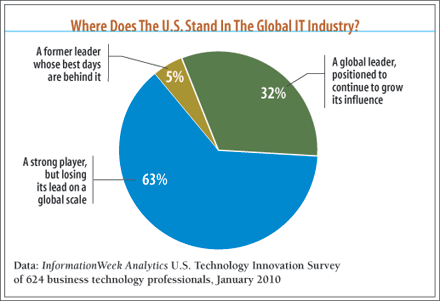Innovation Mandate: Has America Lost Its Innovation Edge?
In an ongoing series of articles, opinion columns, and executive interviews, InformationWeek will explore the issues driving and holding back U.S. tech innovation. First up: What our extensive research tells us.

 InformationWeek's Series On U.S. Tech Competitiveness
InformationWeek's Series On U.S. Tech Competitiveness
For the better part of a decade, executives, economists, policy makers, researchers, and other so-called experts have lamented the inexorable decline of the U.S. IT industry and the country's standing as the global technology leader. Reports with ominous titles have questioned whether U.S.-based IT vendors and the organizations they sell to have the technical chops, national backing, and requisite will to out-innovate their counterparts in other countries.
Economic pessimism is nothing new in the U.S. In his 1988 book Trading Places, Clyde V. Prestowitz Jr., a former U.S. trade negotiator, argued that Japan would overtake the U.S. as the world's preeminent industrial power, mostly because the country's mighty ministries were working hand-in-hand with its mighty keiretsu to dominate sector after strategic sector, including semiconductors. More recently, in "Rising Above The Gathering Storm," an influential report published in 2007, several leading U.S. executives, researchers, and academics warned that "the scientific and technological building blocks critical to our economic leadership are eroding at a time when many other nations are gathering strength."
It's not just the intelligentsia who see a decline in U.S. technology competitiveness. When asked in an InformationWeek Analytics survey to describe where the U.S. stands in the global IT industry, 63% of the 624 business technology professionals who responded characterized the U.S. as "a strong player, but losing its lead on a global scale," while 5% see the U.S. as "a former leader whose best days are behind it." Only 32% of survey respondents still see the U.S. IT industry as "a global leader, positioned to grow its influence."
While InformationWeek's editors can relate to the sense of national urgency, especially as the U.S. limps out of the worst recession in decades, we remain bullish. Most of the profound IT-based innovations of the past decade came from-and continue to come from-the U.S., not Asia or Europe.
U.S.-based companies are the global leaders in developing and mass marketing most emerging consumer and business information technologies, including social networking and myriad other Web applications; Web app marketplaces; e-readers and tablets; cloud computing; software as a service; server virtualization; and commercial open source. And U.S.-based vendors still lead in most of the mature IT sectors: microprocessors, PCs, databases, business intelligence, storage, content management, data center hardware and software, operating systems, networking, network and systems management, consulting and integration services, and outsourcing. The strategic area where our survey and interview subjects agree that U.S. tech companies are furthest behind those in other countries: public telecom.
More In This Series
InformationWeek's Series On U.S. Tech Competitiveness 
Slate Of Concerns
So why do some of the industry's leading lights as well as our survey respondents think that U.S. tech competitiveness is in trouble? Their concerns run the gamut:
>> The offshoring of technology jobs to India and other countries is discouraging young Americans from pursuing tech careers and shipping innovation abroad. Among the 427 survey respondents who think the U.S. is losing or has lost its technology leadership position, 66%--the single highest percentage--cite offshore job movement as one of the top three reasons.
>> The U.S. education system isn't adequately preparing young students in the so-called STEM subjects--science, technology, engineering, and math--and U.S. companies aren't giving their employees sufficient technical training. Some 58% of the 427 survey respondents who think the U.S. is losing or has lost its technology leadership position cite a failure in education as a main reason. Most (though not all) of the more than 40 industry experts we interviewed agree.
>> The U.S., unlike Singapore, South Korea, Japan, Sweden, and several other countries, hasn't had a cohesive national policy in technology areas such as mobile payments, intelligent electricity grids and transportation systems, green computing, and (until recently) broadband and electronic health records. Some 30% of the 427 respondents to our survey worry about a lack of technology leadership at the U.S. national policy-making level.
>> The U.S. government and U.S.-based companies don't spend enough on tech-based R&D and long-term innovation. Some 25% of the 427 survey respondents think "lack of leadership at the tech CEO level," including R&D investment, is a main reason for eroding U.S. tech competitiveness.

>> The U.S. makes it too hard for foreign-born technology professionals, particularly the brightest and most skilled, to come to this country--or to stay here after they graduate from U.S. universities--to start businesses or help build existing ones. Here, there's a gaping disconnect between what our survey respondents think and what the industry leaders we interviewed think. While only 9% of the 427 survey respondents cite visa and immigration restrictions as a major issue, almost all the scores of executives, entrepreneurs, researchers, and academics we interviewed for this report cited it among the top reasons they're concerned about U.S. technology competitiveness and innovation over the long haul.
>> Young Americans are less willing than young people overseas, especially in Asia, to put in the hard work and long hours the IT profession demands, or they're more interested in pursuing higher-paying, more stable jobs in other fields (see: Innovation Mandate: Valero Execs On Keys To U.S. Success). Some 24% of the 427 survey respondents cite "a societal culture that emphasizes other high-paying professions over IT professions" as a main concern; and 21% cite "a corporate culture where tech workers are no longer 'hungry' enough to out-innovate counterparts based abroad."
>> Intellectual property developed by U.S.-based companies is leaking abroad, either because that R&D and design work is being farmed out to companies or divisions in other countries or because foreign companies and governments are stealing it. Some 18% of the 427 survey respondents cite this as a main concern.
>> Stagnant U.S. financial markets aren't spawning enough early- and midstage technology innovators, and those promising companies that do get off the ground typically are acquired before they can really soar. We didn't ask about tech industry venture capital, IPOs, and consolidation in our survey, but several of the experts we interviewed cite this area as a major vulnerability.
Some observers go so far as to say that Silicon Valley, long the center and symbol of U.S. technology innovation, could go the way of Detroit: its key industry players too set in their ways and too overwhelmed by rising costs and onerous taxes and regulations to lead long term (see chart, below).

The U.S. Standing Globally
Several major economic development organizations and think tanks have attempted to compare and rank the U.S. and other countries' tech competitiveness and innovation, and they've come to mixed conclusions.
Most keen on the U.S. is the World Economic Forum, whose "Global Competitiveness Report 2009-2010" ranked the U.S. second among 133 countries, though its analysis went beyond science and technology competitiveness, factoring in broader legal, market, and other attributes.
Among the U.S. strengths cited in the WEF report: its sophisticated and innovative companies, a first-rate university system "that collaborates strongly with the business sector in R&D," its flexible and affordable labor force, and the scale opportunities "afforded by the sheer size of its domestic economy." Besting the U.S. was only Switzerland, recognized for its high spending on R&D, its relatively large number of patents, its strong infrastructure and rule of law, and the tight collaboration between its academic research institutions and sophisticated business sectors. Singapore, Sweden, and Denmark finished third, fourth, and fifth in the WEF ranking.
A February 2009 report by the Innovation Technology and Innovation Foundation, a Washington-based think tank, was less sanguine about the U.S. standing. The ITIF ranked the U.S. sixth among 40 countries in its ability to compete on the basis of innovation. Its ranking factored in 16 indicators in six broad areas, including VC investment and entrepreneurship, broadband infrastructure, scientific research, business climate, and R&D spending.
Ahead of the U.S. in its analysis, which was adjusted for the size of each country's economy and population, were Singapore, Sweden, Luxembourg, Denmark, and South Korea. For instance, the ITIF's report hailed Singapore's recruitment of leading scientists and technologists from around the world, as well as South Korea's "favorable corporate tax policies and agencies," like the South Korea Information Agency and the Industrial Technology Foundation.
The real attention-grabber of the ITIF report was its assessment of national progress in innovation-based competitiveness since 2000. Here, it ranked the U.S. dead last among the 40 countries it assessed (China ranked first in innovation progress, Singapore second, India 14th). Absent a formal national innovation strategy (more on that subject later), the U.S. is likely to fall from its No. 6 perch in the overall rankings, the report concluded.
Most recently, a report on U.S. technology competitiveness by the National Science Board, released in January, maintained that the U.S. continues to lose its lead to China and other Asian countries as they emphasize science and technology in their national development policies. While R&D spending in the U.S. has risen 5% to 6% a year over the past decade, the NSB report said, R&D spending in Asia has grown in the 9% to 10% range, and more than 20% in China. The report noted that those increases are both government-funded and the result of increased spending by multinational companies doing R&D in Asian countries.

Before you leap to the conclusion that the sky is falling on U.S. high-tech innovation, understand that some vested interests are at play.
One of the most vocal doomsayers is the National Science Board, a group of 25 academic advisers appointed by the president. They have a clear stake in advocating for more favorable STEM education funding and policies because their institutions would be among the direct beneficiaries. In the private sector, tech vendor executives are calling for more tax incentives and government funding of R&D, as well as more open labor markets, not only out of a sense of national interest, but also to feed their companies' growth prospects. Critics argue that what's best for the likes of IBM and Intel isn't always best for America. U.S. Commerce Secretary Gary Locke is exhorting policy makers and companies to close the country's "innovation deficit" in the context of rallying support for the Obama administration's healthcare, clean energy, and other priorities, but by most accounts, the U.S. still runs a healthy innovation surplus, particularly in IT.
Even in areas where U.S.-based companies don't lead, they're driving disruptive innovation. Take cell phones and smartphones--Finland's Nokia and Canada's Research In Motion hold the most market share and Korean, Japanese, and Taiwanese device manufacturers remain strong. Yet the hottest software platforms are coming out of two U.S. companies: Apple with the iPhone, and Google with Android. Where the U.S. doesn't excel is in the commodity product businesses such as memory, disk drives, and other components, but those aren't particularly strategic.
Gary Curtis spends about 20 weeks a year traveling outside the U.S. as chief technology strategist for IT services giant Accenture, which is incorporated in Ireland, has headquarters in Chicago, and has offices and operations in 52 countries, including more than 35,000 employees in India. So when Curtis says he thinks the U.S. still leads the world in IT innovation, it's not because he hasn't listened to the views of business technology leaders abroad or seen their innovations firsthand. "In my travels around the world, the top executives in almost every large company have strong respect for America's leadership in technology innovation," Curtis says. "And not just hard technologies like faster processors, faster storage technologies, and the like, but also in the way technology is used to change business and life. Social networking grew up in America, and now it's a worldwide phenomenon."
That continued leadership also is "self-evident by the flow of talent that comes into America--technologists, technology innovators, entrepreneurs," Curtis says. Walk the halls of Google-- "certainly one of the most innovative companies in the history of technology"--and you'll find one of the most ethnically diverse places in the world, he says. That's because people still come to the U.S. from around the world to find technology opportunity--and financial fortune.
Curtis also points to Apple, whose iPod and online store made by-the-track, digital downloads the predominant way people buy music. "If you talked to people 10 years ago in the music industry, they would've told you that's impossible-impossible to do, no one will do it, too much money at stake, consumers will never accept it, blah, blah," Curtis says. "Guess what? Apple did it. And they didn't ask anyone. They just did it. And they did it on the back of revolutionary devices and entrepreneurial spirit, and a vision that music sort of had a new role in life, enabled by these new technologies." Then as an encore, Apple unleashed the mobile Internet via the iPhone, which after just three years has more than 15% of the global smartphone market; the latest model, iPhone 4, sold 1.7 million units in just its first week.
Or consider Salesforce.com, started in Silicon Valley in 1999, at the height of dot-com mania, as a handy little online service for salespeople to manage their accounts. Today, Salesforce is not only a profitable $1.3 billion company, but it's also emblematic of a much broader IT movement: software as a service. The vendor's Force.com is an innovation engine unto itself, a platform on which partners have built or uploaded more than 135,000 project management, HR, financial, and other applications. All the major enterprise software vendors, including SAP, Oracle, and Microsoft, are scrambling to develop SaaS versions of their products to compete with Salesforce and a host of mostly U.S.-based SaaS vendors that have emerged in its wake.
What the pessimists and alarmists underestimate about the U.S., the optimists say, is the creative power of American entrepreneurism and risk taking, and how much the world's biggest, most open IT market stimulates local innovation (and quickly dispenses with also-rans). Just as Japan's top-down industrial policies and protected markets failed to produce the world's most innovative and successful IT companies over the past couple of decades, so will those kinds of policies and bureaucracies come up short in the rest of Asia, as well as in Europe and other regions, their critics say.

Societal Laggard
Robert Atkinson, president of the ITIF, the Washington think tank whose report on innovation we cited earlier, acknowledges that U.S.-based companies still lead the world in producing IT products. They also lead the world in applying IT to mainstream enterprise areas such as supply chain management, customer relationship management, and business intelligence, and to specific industry uses like airline reservations, retail point of sale, financial trading, and package delivery.
Atkinson argues, however, that the U.S. is starting to lag other countries in rolling out "societal" IT applications--areas such as mobile payments, intelligent transportation, and smart cards that require intense collaboration and standardization across the private and public sectors and where government funding, incentives, and coordination can be critical.
Take, for instance, intelligent transportation, which includes systems that provide drivers with real-time road and traffic information, systems that manage pricing and traffic flows, and systems that enable communications from vehicles to roadside sensors, traffic lights, and even other vehicles. ITIF senior analyst Stephen Ezell argued in a January report that the U.S. lags Japan, Singapore, and South Korea in this area for two main reasons: lack of funding and lack of federal (as opposed to individual state) leadership.
Google CEO Eric Schmidt, in an op-ed piece this year in The Washington Post, argued that the U.S. can no longer rely on the top-down approach to technology innovation that was common in the 20th century, when the military and NASA and insulated, private research institutions such as AT&T Bell Labs produced breakthroughs that eventually "spun off to the wider economy."
Schmidt laid out five action items: Hold the U.S. Congress accountable for promoting vibrant competition "over protecting the interests of incumbents"; tolerate failures in our government-funded efforts, especially in cutting-edge industries like clean tech; increase funding and tax incentives for corporate R&D; extend broadband access through government funding (something a recently unveiled FCC plan stipulates); and make it easier for talented technologists to stay in this country after graduating from U.S. universities.
Schmidt's most important point: Now that "the Internet has put abundant information and powerful tools in everyone's hands, innovation is often driven from the bottom up. More than ever, innovation is disruptive and messy. It can't be controlled or predicted. The only way to ensure it can flourish is to create the best possible environment-and then get out of the way. It's a question of learning to live with a mess."
Innovation is indeed a messy affair. As I argued in a recent column introducing InformationWeek's Innovation Mandate project, the free market system has proved to be the best at consistently producing technological breakthroughs and commercial successes. But it's rarely benign. "Silicon Valley remains the epicenter of global tech innovation and a source of abundant job and wealth creation because the competition is so cutthroat, the potential rewards are so great, and the flow of ideas and talent is so open," I wrote, "not because everything is neat and orderly and guaranteed to deliver 'fair' outcomes."
In the coming months, we'll dive deeper into the issues driving and impeding global technology innovation. Join us on InformationWeek.com in this Innovation Mandate discussion and debate. It's an issue that's critical to promoting economic development and elevating standards of living. -- Chris Murphy and Doug Henschen contributed to this story

Become an InformationWeek Analytics subscriber: $99 per person per month, multiseat discounts available.
Subscribe and get our full Innovation Mandate report. This report includes 43 pages of analysis and 23 survey charts. What you'll find:
An analysis of the relative innovation strengths and weaknesses of India, China, and other countries
More insights from CEOs, CIOs, CTOs, researchers, and other leading industry players
About the Author(s)
You May Also Like
How to Amplify DevOps with DevSecOps
May 22, 2024Generative AI: Use Cases and Risks in 2024
May 29, 2024Smart Service Management
June 4, 2024







